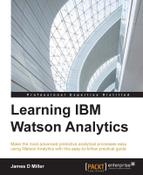Part of your enterprise roadmap must eventually include upgrading to (ultimately) the professional version of IBM Watson. Simply put, you start with the free version for your test drive, upgrade to the personal version to develop your personal expertise, and you go pro (with the professional version) when you are ready.
Let's revisit the differences between the currently available versions of IBM Watson.
What do you get for nothing? In this case, a lot. The free version gives you all of Watson's core functionalities (access to cognitive, predictive and visual analytics) and lets you experiment and evaluate on your own schedule. Keep in mind that once you register as a Watson user you also have access to the Watson online communities.
The free version includes:
- Web access for 1 user
- Limit of 100,000 rows and 50 columns (per data file)
- 500 MB of storage
- Ability to upload delimited files and Microsoft Excel files
In the personal version of Watson, you get all of the free version features, access to Twitter data, and the ability to work with larger data files:
- Web access for 1 user
- 1,000,000 rows and 256 columns limit (per data file)
- 2 GB of storage
- Ability to upload delimited files and Microsoft Excel files
- Access to more sources of data
- Access to social data from Twitter
When your organization is ready, the Watson professional edition adds support for a multi-user environment for collaboration and more data connectors. Note that even the product documentation is version specific, that is, information documenting these features is only available after you upgrade: You need a Watson Analytics Professional edition account to get access to the database connections:
- Allows multiple web users
- 10,000,000 rows and 500 column limit (per data file)
- 100 GB of storage
- The ability to upload delimited files and Microsoft Excel files
- Access to more sources of data, including IBM DB2, dashDB, SQLDB, Microsoft SQL Server, MySQL, Oracle and PostgreSQL (as of this writing)
- Access to social data from Twitter
- Ability to connect to IBM Cognos report data
- Access to share data sets, refined data sets, explorations, predictions, and views
